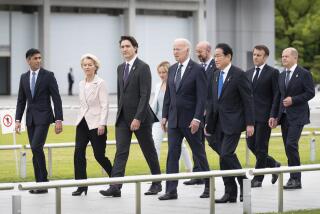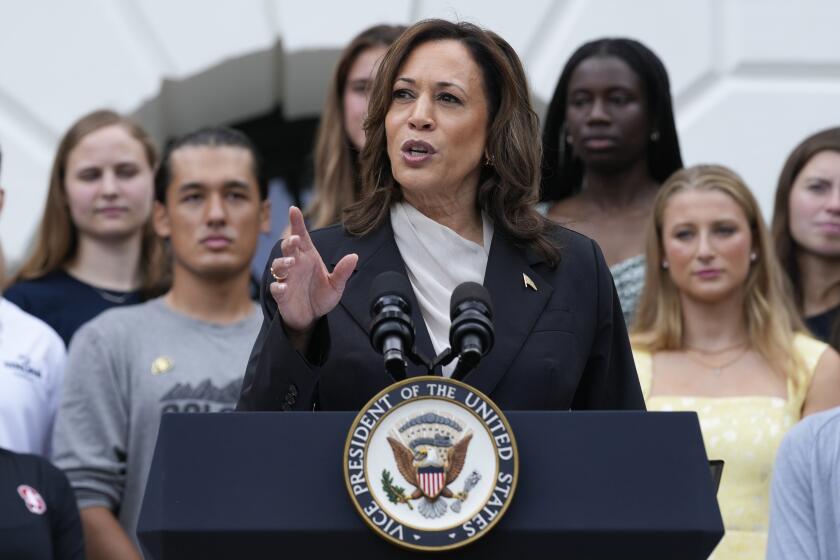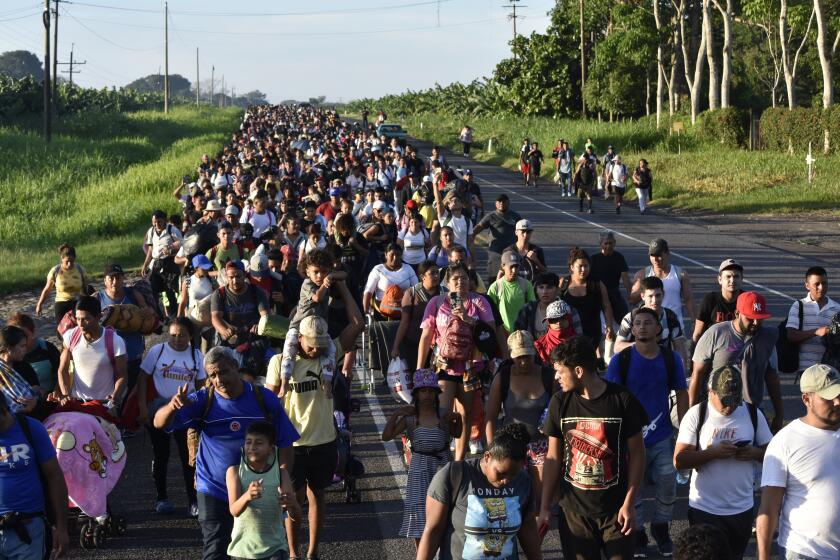Noriega Not in His Office, Coup Plotters Discovered
Rebellious officers mistakenly believed that Gen. Manuel A. Noriega was inside his downtown headquarters when they seized the compound in a failed plot to kidnap the Panamanian dictator, informed American and European officials said Wednesday.
The sources, who reconstructed Tuesday’s coup attempt, said that the rebels were backed by no more than 200 soldiers and did not expect to spark a massive military uprising.
Instead, the sources said, the rebels’ strategy was to hold their commander in chief hostage, negotiating for his removal and the retirement of the Panama Defense Forces’ general staff.
The revolt, which began with gunfire at 7 a.m., failed when the rebels discovered that Noriega was not in the four-story compound, the sources said. After five hours of heavy fighting, the rebels surrendered.
“The key flaw in their plot was that they had expected Noriega to be in the headquarters,” a U.S. official said. “The idea was to hold him hostage. When he wasn’t there, they didn’t stand a chance.”
The sources, who spoke on condition of anonymity, contradicted a U.S. intelligence report Tuesday that Noriega was in the compound at the time of the uprising. Some members of Congress, given that report by the CIA, reacted with outrage that U.S. troops stationed nearby to guard the Panama Canal did not intervene to arrest the general.
On Wednesday, 1,500 cheering Noriega supporters surrounded the battered military headquarters, throwing kisses and salutes to officers. Periodically, Noriega appeared in fatigues at a second-story window and raised a clenched fist in triumph.
“The people love Noriega because he’s the only one who’s ever done anything for us,” Rufina Castillo, 59, shouted over the music of a brass band. “Because of him we have housing.”
Soldiers puttied and painted over craters in the facade of the headquarters building and carried bags of cement and cinder blocks inside the compound to repair damage from Tuesday’s battle.
“The U.S. government is stepping all over us,” said Virginia Saenz, 53. “We believe the (rebel soldiers) were paid a lot of money. They sold out.”
Banner Headlines
The Panamanian government charged again Wednesday that the Bush Administration, which openly seeks the general’s ouster, masterminded the revolt. “Failed Coup Was Coordinated With U.S. Southern Command,” declared a red banner headline in the pro-government newspaper Critica.
As evidence of U.S. involvement, Noriega’s provisional president, Francisco Rodriguez, told the United Nations on Wednesday that his government has photographs showing U.S. troops and military vehicles blocking access to the headquarters Tuesday.
A Panamanian military source said U.S. roadblocks were in place three hours before the first shots were fired.
Pentagon spokesman Pete Williams said some roads may have been blocked by U.S. tanks trying to seal off and protect American bases 600 yards away after the trouble started.
Troops on Alert
About 12,000 U.S. troops stationed at the Southern Command’s bases at Quarry Heights and Ft. Amador on the western edge of Panama City remained on alert Wednesday. Movements of U.S. personnel were restricted.
The Panamanian government kept an 8 p.m. to 5 a.m. curfew in force.
The coup attempt, the second against Noriega in 19 months, was led by four mid-level officers and troops from the Urraca Company, which was assigned to protect the 51-year-old Noriega’s headquarters. Officials and witnesses gave this account:
At 7 a.m., the first gunshots rang through the poor El Chorillo neighborhood, where the headquarters is located. Hundreds of residents fled with their belongings and, in some cases, their pets, as police moved in with water cannon and armored personnel carriers.
By 7:20 a.m., the U.S. Southern Command had put its troops on highest alert. Gunfire continued in the streets, nicking buildings and shattering the windows of parked cars.
U.S. troops in combat gear took up positions around their bases. U.S. helicopter gunships and Blackhawk troop carriers flew over the Bridge of the Americas, which crosses the Panama Canal west of the city.
Meanwhile, troops loyal to Noriega moved in. The elite Battalion 2000, named for the year Panama is to take full control of the canal, made its way from Ft. Cimarron, 25 miles east of the city; the Machos de Monte unit came from Rio Hato, 55 miles to the west.
At 11:30 a.m., rebels issued a communique, signed first by Maj. Moises Giroldi Vega, commander of the Urraca Company. Read in a radio broadcast, the communique said that Noriega and six of his top colonels had been “retired.” The mutineers called on other units to join them and promised to hold elections soon.
Celebrations in Streets
Hundreds of opposition supporters took to the streets to celebrate, but within half an hour, forces loyal to Noriega called a local television station to say they were fighting back. The loyalists surrounded the compound and bombarded it with grenades and rocket fire.
By 1 p.m., Noriega loyalists had regained control, although sporadic gunfire continued for several hours.
In reconstructing the events, several sources speculated that Noriega’s men had anticipated the plot and tricked security guards at the headquarters into believing that the general was there. Noriega seldom uses his downtown office, spending most of his workday at Ft. Amador, an installation shared by U.S. and Panamanian army units.
None of the sources could say where Noriega was during the revolt. He was not seen in public until he appeared on television at 4 p.m., denouncing the coup as part of the United States’ “permanent aggression” against Panama.
A U.S. source familiar with Tuesday’s events refused to say whether the United States had provided the rebels with intelligence on Noriega’s supposed movements.
In Washington, White House spokesman Marlin Fitzwater acknowledged that U.S. officials learned of the plot last weekend, but he denied there had been any U.S. military support.
The U.S. source denied that any deals were made with the rebel officers, but he said the rebels were told that the Bush Administration would like custody of Noriega if he were apprehended.
According to a senior U.S. official in Washington, Defense Secretary Dick Cheney briefed lawmakers Wednesday night, telling them of a discussion between an officer of the U.S. Southern Command and two of the leaders of the attempted coup. The American officers offered to “relieve them of Noriega, take him off their hands,” said a defense official, recounting Cheney’s report. The Panamanian officers declined the offer, saying they did not wish to extradite Noriega but wanted to permit him to retire within the country.
The official said Cheney and other Pentagon officials assumed that the officers were holding Noriega, but added, “We never knew for certain.”
Sanctuary to Plotters?
The Panama Defense Forces said further proof of U.S. involvement was a report that two of the plotters took refuge at Ft. Clayton, a U.S. military base in the Panama Canal Zone. The two were not identified. U.S. officials refused to confirm or deny the report.
Panamanian newspapers said six people were killed in the coup attempt, including Maj. Giroldi. The report has not been confirmed by official sources.
On Tuesday, Defense Forces spokesman Maj. Edgardo Lopez said several people had been wounded but none killed. He said that at least 60 soldiers and four officers were arrested.
Panamanian officials have said there was no civilian involvement in the uprising. But opposition leader Ricardo Arias Calderon said Raul Ossa, a vice president of the Christian Democratic Party, was arrested following the revolt, for reasons unclear to Arias.
President Bush first called for Noriega’s overthrow last May after the general nullified an election that international observers said his handpicked candidate had lost.
Noriega, a favorite in Washington when he became commander in 1983, has been the object of official U.S. enmity since February, 1988, when federal grand juries in Florida indicted him on racketeering and cocaine conspiracy charges for allegedly turning Panama into a safe haven for Colombian drug lords.
The dictator has accused the United States of seeking his removal in order to nullify the 1977 treaties and retain control over the Panama Canal.
U.S. Denounced
Outside his bullet-pocked headquarters Wednesday, Noriega declared to his supporters, “The U.S. imperialists are like piranha fish and want to gobble up the Panama Canal.”
After surviving a coup attempt in March, 1988, Noriega purged his high command of potentially disloyal officers. He created the Strategic Military Council, a parallel command of loyal captains and majors.
A military source said that Maj. Giroldi had actively opposed the 1988 coup attempt and, as a result, was promoted from captain to major, but he was not given a seat on the new council.
Diplomatic sources said the great majority of the 14,000-member Defense Forces ignored Giroldi’s plea for support in Tuesday’s uprising. The cavalry headquarters in Panama City’s old colonial section was apparently the only other installation involved in the fighting.
None of the rebel leaders belonged to the high command or the Strategic Military Council.
So far, divisions in the armed forces do not appear to go beyond the approximately 200 soldiers said to have taken part in the revolt. But while Noriega quickly put down the uprising and has demonstrated his military support, diplomats say the revolt is bound to damage him.
“You cannot say after a coup attempt that Noriega is stronger,” said a European diplomat. “If you have one, two, three attempts, statistically one day the man is going to fall. But because of this (failure), I would say nothing else is going to happen for at least another year.”
Added another diplomat: “Noriega looks stronger now, but he could be like the ill patient in remission.”
U.S. WEIGHS OPTIONS: The U.S. has not ruled out using force to oust Noriega.
More to Read
Sign up for Essential California
The most important California stories and recommendations in your inbox every morning.
You may occasionally receive promotional content from the Los Angeles Times.






